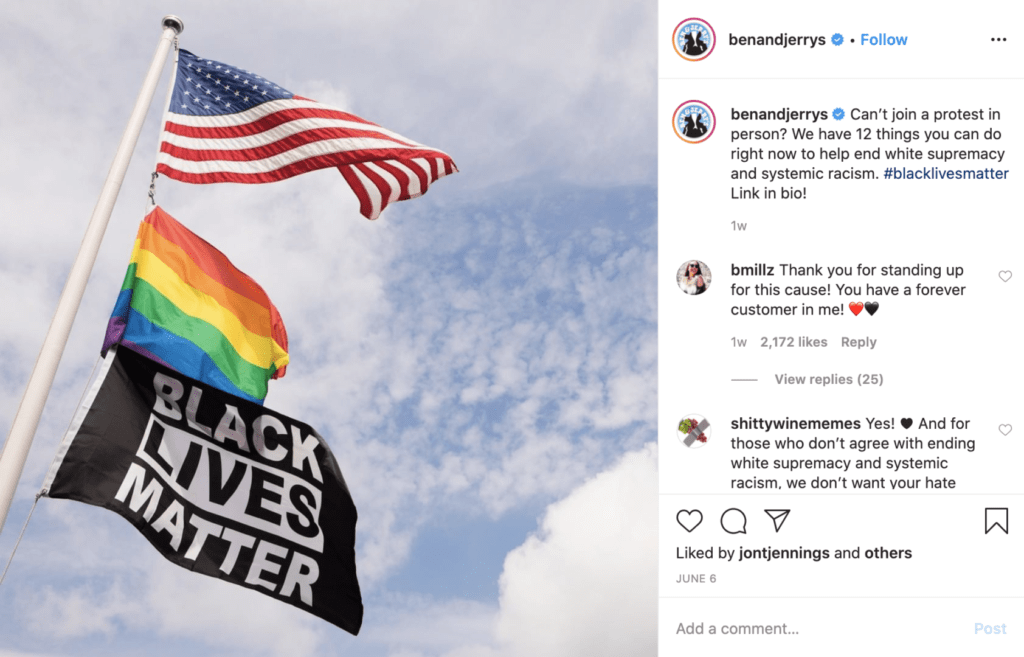July 19, 2020
Social Media Advertising and Its Place During Social Unrest
Kaitlin Cwikla

Using Social to Call Out Social Injustices
If you’re one of the 1 billion people that uses Instagram every month, you probably noticed things were emptier than usual on June 2nd. But in reality, the platform was filled with a strong and succinct message to help amplify the voices of black people everywhere after the heinous murder of George Floyd. The #BlackoutTuesday movement, started by Brianna Agyemang and Jamila Thomas, provided a call-to-action for people to silence their social media accounts in protest of police brutality and racial injustice by posting a black square to their feed. This wasn’t your average viral sensation. Garnering over 28 million uses, the hashtag #BlackoutTuesday went beyond viral, and gave rise to sweeping, international action across social media.

While it is just a mere drop in the bucket for the movement, #BlackoutTuesday shows us just how powerful social media can be in times of social injustice and world crises. It also shows how much power one person has with just access to an Instagram account. Today’s societal landscape is history in the making, and it’s crucial that as advertisers, we understand how to—or how not to—react.
Understanding Our Role in Social Issues
Among the millions who shared their silence during #BlackoutTuesday, a number of brands joined in to show their support for the Black Lives Matter movement. Some were well received and others, not so much. Your consumers know more about your brand and your values than you think, and there’s a very fine line to walk when considering voicing an opinion on something so politically charged—especially if you have not shown your support in the past. If you think your only contribution to the Black Lives Matter movement is posting a black square and calling it a day, then you have a long road ahead of you and could be in for some backlash and criticism from your consumers. As advertisers, we have the platform and the opportunity to make waves and elicit change, and if we don’t use that platform consistently it will be noticed by our consumers. Brand values are the subject of scrutiny in times like these, and it’s important to be consistent and sincere—not reactionary as a marketing ploy, which can be very transparent and off-putting to consumers.
While siding with a particular issue should be apparent and ongoing long before a horrific event occurs, sometimes a company’s values change in light of these events. If yours has and you feel moved to side with a current issue, do so wholeheartedly and thoroughly. Posting a black square and returning to normal programming if support of the movement hasn’t been previously apparent isn’t enough. You’ll need to put in the extra work to show your customers your company values have changed and express your investment in the statement you’re making.

Allowing Your Brand to Be Human
Social media allows us to connect more intimately with our audience than any other form of advertising. As a medium where there is two-way communication, everything that advertisers do has the capability to be scrutinized by the public. This doesn’t mean you should completely ignore major social issues, though. There is a growing interest in brands that show their acts of goodwill and humanity, because consumers today are looking for authenticity. So take the time to make sure what you’re saying adds value to the conversation, and aligns with the values that you’ve previously set aside for your business.
So, how can we humanize our brands more effectively on social media without it seeming forced? Here are a few steps you can take to creating a more approachable, authentic brand that can help make a difference and show your audience what you stand for:
- Listen. Use social listening to hear what your audience and others outside of your audience are saying. What’s the overarching message? What is the mood?
- Understand. Social media for brands is not the place for personal bias. Being open-minded and understanding every side to a story helps ensure your content is as accurate as possible. And, although social is a reactive industry, take the time to comprehend the message that is being put out by others and be willing to adjust as things change.
- Be Authentic. Nothing is worse than an opportunistic company, and we’ve seen plenty of exploitative reactions to the hardships that have occurred thus far in 2020. Use what you know about your brand and what your company stands for, then determine not only if your response is adjacent to and reflects those values, but also that the situation is worth your input.
- Adjust. In the off chance that you make a mistake, or don’t consider the steps above, be willing to adapt based on your audience’s feedback if warranted. A brand that comes forward with a genuine apology is 10x better than a brand that sticks their head in the sand. Find a way to make amends with your community, and understand that it won’t happen overnight.
There will always be importance in having an approachable brand, especially on social media. We all unite over one thing—humanity. It’s what connects us and makes us who we are. Social media has a similar purpose: to connect people. While it hasn’t been widely used as such in the past or in recent years, we have to remember its origins and understand how to let our humanity have a place in social interactions again—whether they are digital or in person. In a world where Zoom calls are the new staff meetings and birthday parties come in the form of drive-by parades, it’s crucial. Ultimately, we must allow what makes us human to lead who we are behind our screens, and never be afraid to speak up for what we believe in.
Learn how your can help support the Black Lives Matter movement:
- Follow @blklivesmatter and @ckyourprivilege on Instagram
- Donate to the National Bail Fund Network: National Bail Fund Network — Community Justice Exchange
- Support Black Owned Businesses: https://www.forbes.com/sites/elisabethbrier/2020/06/05/75-black-owned-businesses-to-support/#340f606d3814
- Sign a Petition: change.org/p/mayor-jacob-frey-justice-for-george-floyd
- Other ways to help: 8 Ways to Support Black Lives Matter: Protests, Donations and More
Get insights delivered straight to your inbox.